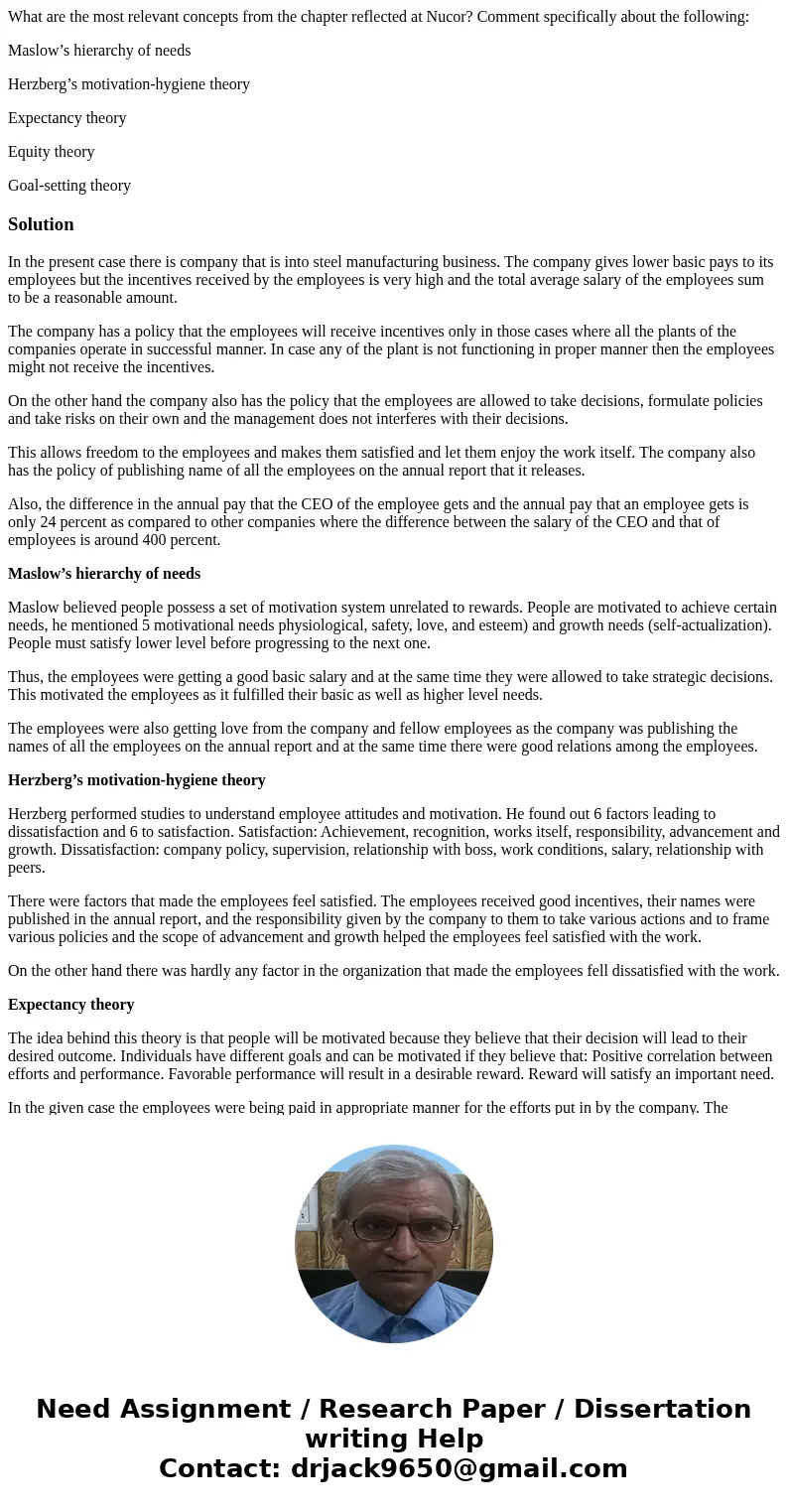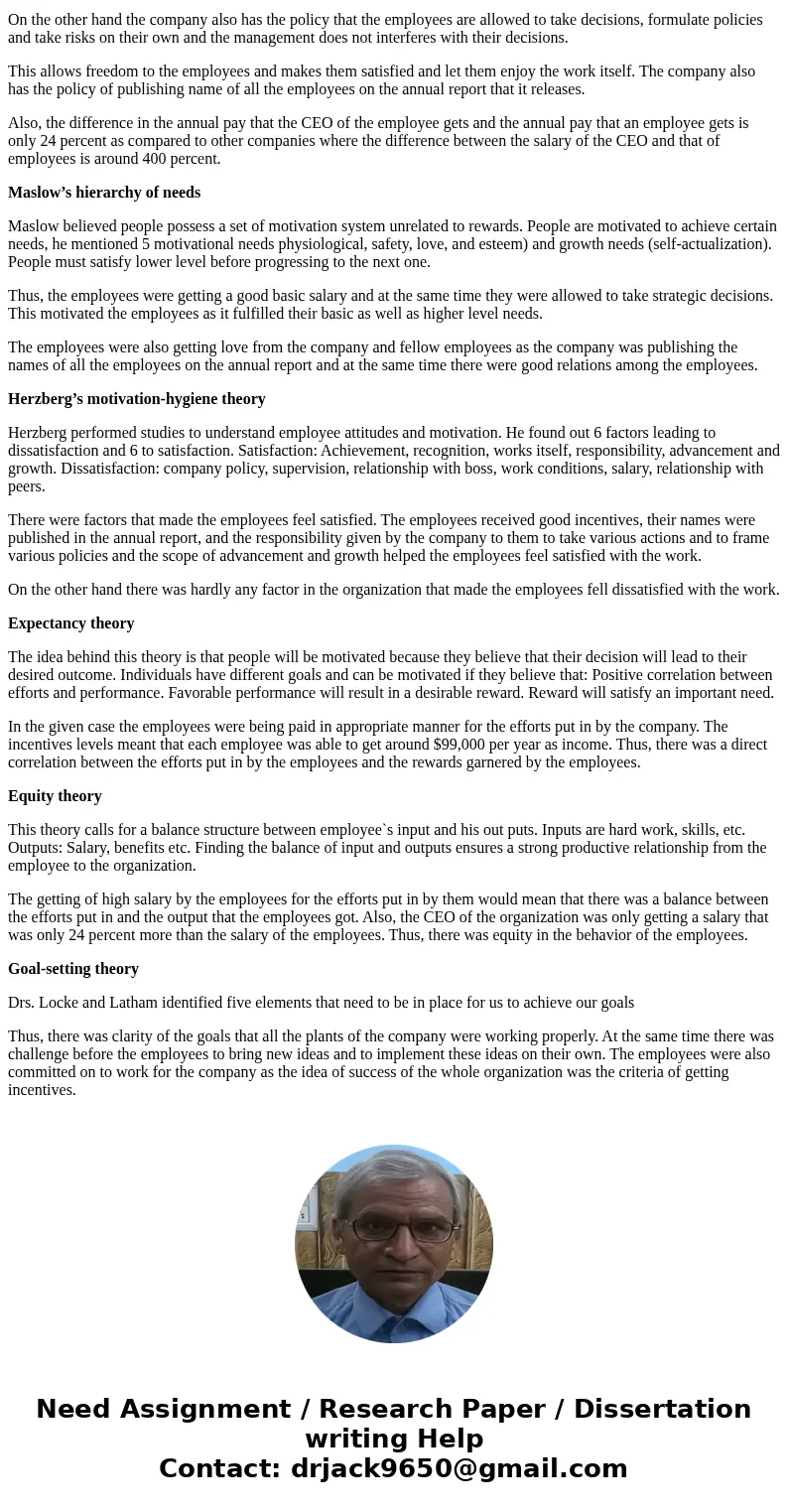What are the most relevant concepts from the chapter reflect
What are the most relevant concepts from the chapter reflected at Nucor? Comment specifically about the following:
Maslow’s hierarchy of needs
Herzberg’s motivation-hygiene theory
Expectancy theory
Equity theory
Goal-setting theory
Solution
In the present case there is company that is into steel manufacturing business. The company gives lower basic pays to its employees but the incentives received by the employees is very high and the total average salary of the employees sum to be a reasonable amount.
The company has a policy that the employees will receive incentives only in those cases where all the plants of the companies operate in successful manner. In case any of the plant is not functioning in proper manner then the employees might not receive the incentives.
On the other hand the company also has the policy that the employees are allowed to take decisions, formulate policies and take risks on their own and the management does not interferes with their decisions.
This allows freedom to the employees and makes them satisfied and let them enjoy the work itself. The company also has the policy of publishing name of all the employees on the annual report that it releases.
Also, the difference in the annual pay that the CEO of the employee gets and the annual pay that an employee gets is only 24 percent as compared to other companies where the difference between the salary of the CEO and that of employees is around 400 percent.
Maslow’s hierarchy of needs
Maslow believed people possess a set of motivation system unrelated to rewards. People are motivated to achieve certain needs, he mentioned 5 motivational needs physiological, safety, love, and esteem) and growth needs (self-actualization). People must satisfy lower level before progressing to the next one.
Thus, the employees were getting a good basic salary and at the same time they were allowed to take strategic decisions. This motivated the employees as it fulfilled their basic as well as higher level needs.
The employees were also getting love from the company and fellow employees as the company was publishing the names of all the employees on the annual report and at the same time there were good relations among the employees.
Herzberg’s motivation-hygiene theory
Herzberg performed studies to understand employee attitudes and motivation. He found out 6 factors leading to dissatisfaction and 6 to satisfaction. Satisfaction: Achievement, recognition, works itself, responsibility, advancement and growth. Dissatisfaction: company policy, supervision, relationship with boss, work conditions, salary, relationship with peers.
There were factors that made the employees feel satisfied. The employees received good incentives, their names were published in the annual report, and the responsibility given by the company to them to take various actions and to frame various policies and the scope of advancement and growth helped the employees feel satisfied with the work.
On the other hand there was hardly any factor in the organization that made the employees fell dissatisfied with the work.
Expectancy theory
The idea behind this theory is that people will be motivated because they believe that their decision will lead to their desired outcome. Individuals have different goals and can be motivated if they believe that: Positive correlation between efforts and performance. Favorable performance will result in a desirable reward. Reward will satisfy an important need.
In the given case the employees were being paid in appropriate manner for the efforts put in by the company. The incentives levels meant that each employee was able to get around $99,000 per year as income. Thus, there was a direct correlation between the efforts put in by the employees and the rewards garnered by the employees.
Equity theory
This theory calls for a balance structure between employee`s input and his out puts. Inputs are hard work, skills, etc. Outputs: Salary, benefits etc. Finding the balance of input and outputs ensures a strong productive relationship from the employee to the organization.
The getting of high salary by the employees for the efforts put in by them would mean that there was a balance between the efforts put in and the output that the employees got. Also, the CEO of the organization was only getting a salary that was only 24 percent more than the salary of the employees. Thus, there was equity in the behavior of the employees.
Goal-setting theory
Drs. Locke and Latham identified five elements that need to be in place for us to achieve our goals
Thus, there was clarity of the goals that all the plants of the company were working properly. At the same time there was challenge before the employees to bring new ideas and to implement these ideas on their own. The employees were also committed on to work for the company as the idea of success of the whole organization was the criteria of getting incentives.


 Homework Sourse
Homework Sourse